A Multistage Design Procedure for Planning and Implementing Public Charging Infrastructures for Electric Vehicles
Abstract
1. Introduction
2. Motivation and Context
- the PCI is funded by the regional government and installed in public spaces; however, since municipality administrations rule installations on public spaces, they must be included as stakeholders throughout the process;
- selecting the most important municipalities is of paramount importance in order to reduce the complexity of the design process and to deal with the limited amount of time and funds;
- CPs installed in mobility attractive and high-population-density areas satisfy the charging demands of both commuters (during the day) and residents (overnight) and, thus, are preferred;
- domestic charging is considered by assuming that all EVs leaving home commute with sufficient autonomy to reach the destination; this is reasonable because the distance covered by all commuting trips that occur in Sardinia is much shorter than the average range of EVs;
- only intracity charging instances are considered to design the PCI presented in this paper, as a suitable PCI devoted to intercity charging instances will be developed in a second phase of the project.
3. Multistage Design Methodology
3.1. Stage 1: Macroscale Planning
3.2. Stage 2: Microscale Planning
3.3. Stage 3: Fine-Scale Design
4. Experimental Validation
4.1. Key Performance Indexes
4.2. The Real Case Study: The Island of Sardinia
4.3. Cost Analysis
5. Conclusions
Author Contributions
Funding
Conflicts of Interest
References
- Rodrigue, J.-P.; Comtois, C.; Slack, B. The Geography of Transport Systems, 3rd ed.; Routledge: London, UK, 2013; ISBN 978-0-415-82253-4. [Google Scholar]
- Saidi, S.; Hammami, S. Modeling the causal linkages between transport, economic growth and environmental degradation for 75 countries. Transp. Res. Part Transp. Environ. 2017, 53, 415–427. [Google Scholar] [CrossRef]
- Gherghina, Ş.C.; Onofrei, M.; Vintilă, G.; Armeanu, D.Ş. Empirical Evidence from EU-28 Countries on Resilient Transport Infrastructure Systems and Sustainable Economic Growth. Sustainability 2018, 10, 2900. [Google Scholar] [CrossRef]
- IEA Sankey Diagram. Available online: https://www.iea.org/Sankey (accessed on 16 April 2018).
- International Energy Agency (IEA). Global EV Outlook 2017; IEA: Paris, France, 2017; p. 71. [Google Scholar]
- Energy & Strategy Group. E-Mobility Report; Politecnico di Milano: Milan, Italy, 2017. [Google Scholar]
- Globisch, J.; Plötz, P.; Dütschke, E.; Wietschel, M. Consumer preferences for public charging infrastructure for electric vehicles. Transp. Policy 2019, 81, 54–63. [Google Scholar] [CrossRef]
- Palevičius, V.; Podviezko, A.; Sivilevičius, H.; Prentkovskis, O. Decision-Aiding Evaluation of Public Infrastructure for Electric Vehicles in Cities and Resorts of Lithuania. Sustainability 2018, 10, 904. [Google Scholar] [CrossRef]
- Wirges, J. Planning the Charging Infrastructure for Electric Vehicles in Cities and Regions; KIT Scientific Publishing: Karlsruhe, Germany, 2016. [Google Scholar]
- Dai, Y.; Liu, M. An electricity demand-based planning of electric vehicle charging infrastructure. Wuhan Univ. J. Nat. Sci. 2017, 22, 449–454. [Google Scholar] [CrossRef]
- Davidov, S.; Pantoš, M. Planning of electric vehicle infrastructure based on charging reliability and quality of service. Energy 2017, 118, 1156–1167. [Google Scholar] [CrossRef]
- Akbari, M.; Brenna, M.; Longo, M. Optimal Locating of Electric Vehicle Charging Stations by Application of Genetic Algorithm. Sustainability 2018, 10, 1076. [Google Scholar] [CrossRef]
- Dong, J.; Liu, C.; Lin, Z. Charging infrastructure planning for promoting battery electric vehicles: An activity-based approach using multiday travel data. Transp. Res. Part C Emerg. Technol. 2014, 38, 44–55. [Google Scholar] [CrossRef]
- González, J.; Alvaro, R.; Gamallo, C.; Fuentes, M.; Fraile-Ardanuy, J.; Knapen, L.; Janssens, D. Determining Electric Vehicle Charging Point Locations Considering Drivers’ Daily Activities. Procedia Comput. Sci. 2014, 32, 647–654. [Google Scholar] [CrossRef]
- Zhao, S.Q.; Li, Z.W. The Optimization Model of Planning Electric Vehicle Charging Station. Appl. Mech. Mater. 2014, 672–674, 1183–1188. [Google Scholar] [CrossRef]
- Wood, E.; Rames, C.; Muratori, M.; Raghavan, S.; Melaina, M. National Plug-In Electric Vehicle Infrastructure Analysis; National Renewable Energy Lab: Golden, CO, USA, 2017; p. 74. [Google Scholar]
- Wood, E.; Raghavan, S.; Rames, C.; Eichman, J.; Melaina, M. Regional Charging Infrastructure for Plug-In Electric Vehicles: A Case Study of Massachusetts; National Renewable Energy Lab: Golden, CO, USA, 2017. [Google Scholar]
- Pagany, R.; Marquardt, A.; Zink, R. Electric Charging Demand Location Model—A User- and Destination-Based Locating Approach for Electric Vehicle Charging Stations. Sustainability 2019, 11, 2301. [Google Scholar] [CrossRef]
- De Gennaro, M.; Paffumi, E.; Martini, G. Customer-driven design of the recharge infrastructure and Vehicle-to-Grid in urban areas: A large-scale application for electric vehicles deployment. Energy 2015, 82, 294–311. [Google Scholar] [CrossRef]
- Csiszár, C.; Csonka, B.; Földes, D.; Wirth, E.; Lovas, T. Urban public charging station locating method for electric vehicles based on land use approach. J. Transp. Geogr. 2019, 74, 173–180. [Google Scholar] [CrossRef]
- National Research Council 2015 Overcoming Barriers to Deployment of Plug-in Electric Vehicles; National Academies Press: Washington, DC, USA, 2015; ISBN 978-0-309-37217-6.
- Porru, M.; Serpi, A.; Mureddu, M.; Damiano, A. A Combined Planning and Design Approach of a Public Charging Infrastructure for Electric Vehicles. In Proceedings of the IEEE Vehicle Power and Propulsion Conference (VPPC 2018), Chicago, IL, USA, 27–30 August 2018; p. 5. [Google Scholar]
- Istat.it. Available online: https://www.istat.it/en/ (accessed on 25 June 2018).
- OpenStreetMap. Available online: https://www.openstreetmap.org/ (accessed on 25 June 2018).
- Mureddu, M.; Scala, A.; Chessa, A.; Caldarelli, G.; Musio, M.; Damiano, A. An Agent Based Approach for the Development of EV fleet Charging Strategies in Smart Cities. In Proceedings of the 2nd IEEE International Electric Vehicle Conference (IEVC 2014), Florence, Italy, 17–19 December 2014; pp. 1–8. [Google Scholar]
- Mureddu, M.; Facchini, A.; Scala, A.; Caldarelli, G.; Damiano, A. A Complex Network Approach for the Estimation of the Energy Demand of Electric Mobility. Sci. Rep. 2018, 8, 268. [Google Scholar] [CrossRef] [PubMed]
- Ministero delle Infrastrutture e dei Trasporti. Piano Nazionale Infrastrutturale per la Ricarica dei Veicoli Alimentati ad Energia Elettrica (PNIRE) 2016; Ministero delle Infrastrutture e dei Trasporti: Rome, Italy, 2016.
- Regione Autonoma della Sardegna Prezzario dei Lavori Pubblici. Available online: https://www.regione.sardegna.it/j/v/572?s=1&v=9&c=4365&va=x&esp=1 (accessed on 22 March 2020).
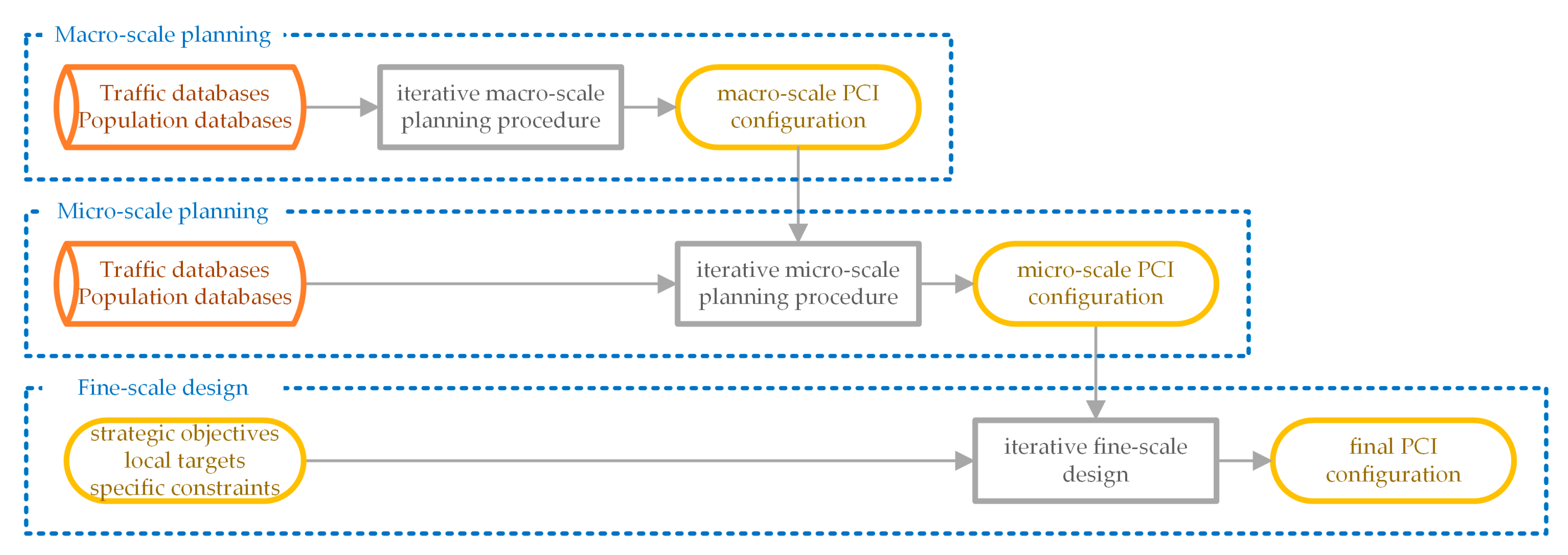
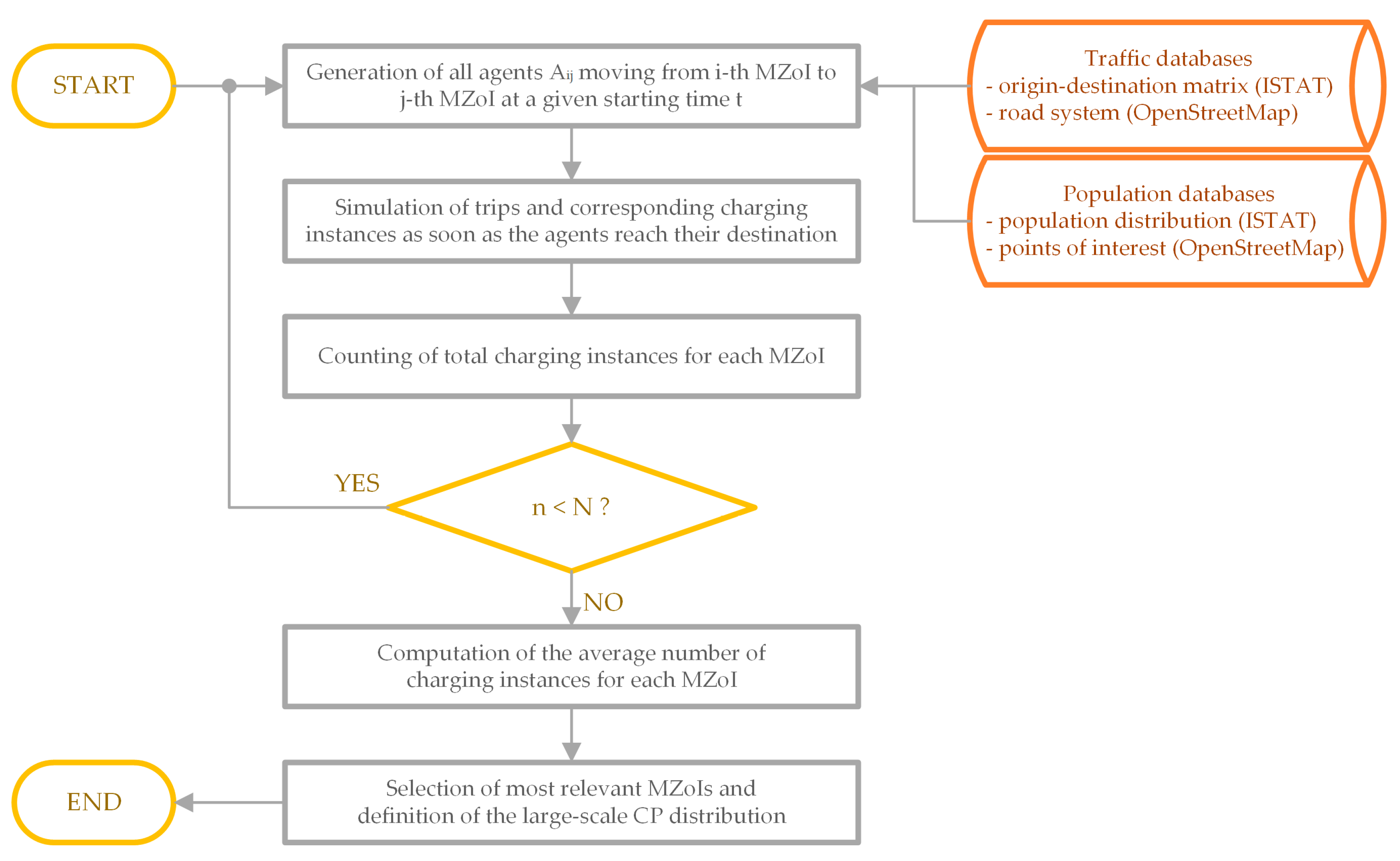

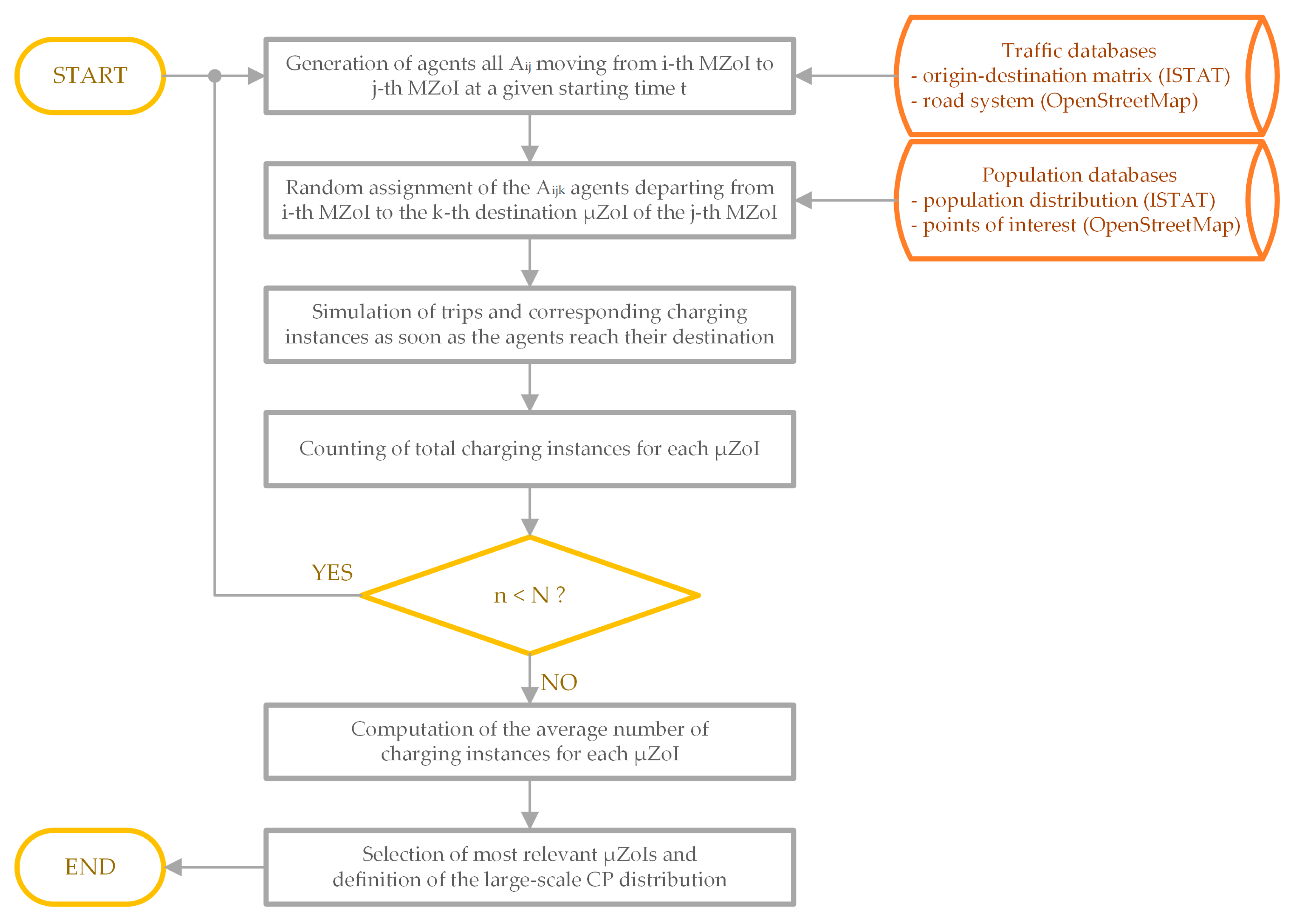

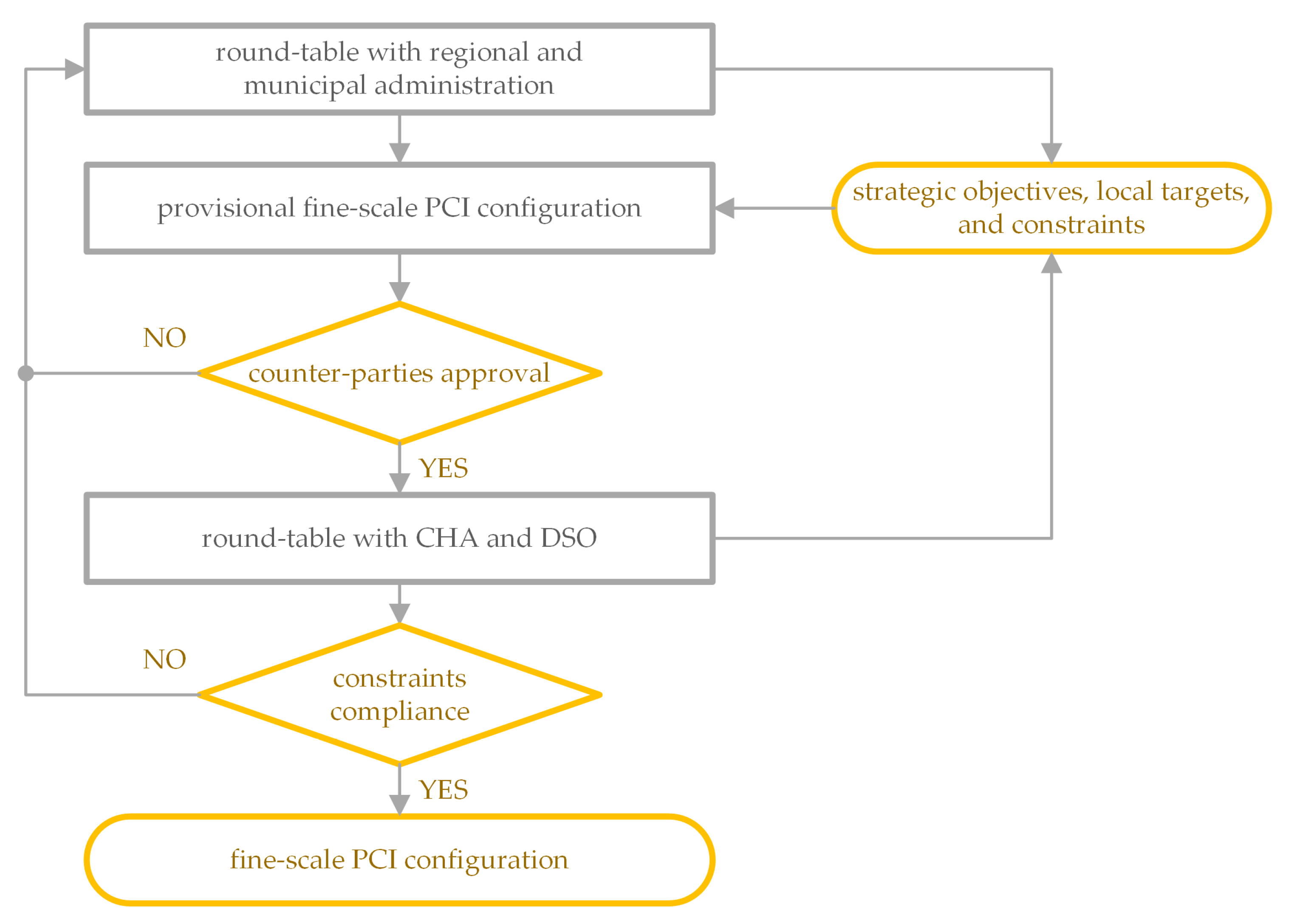
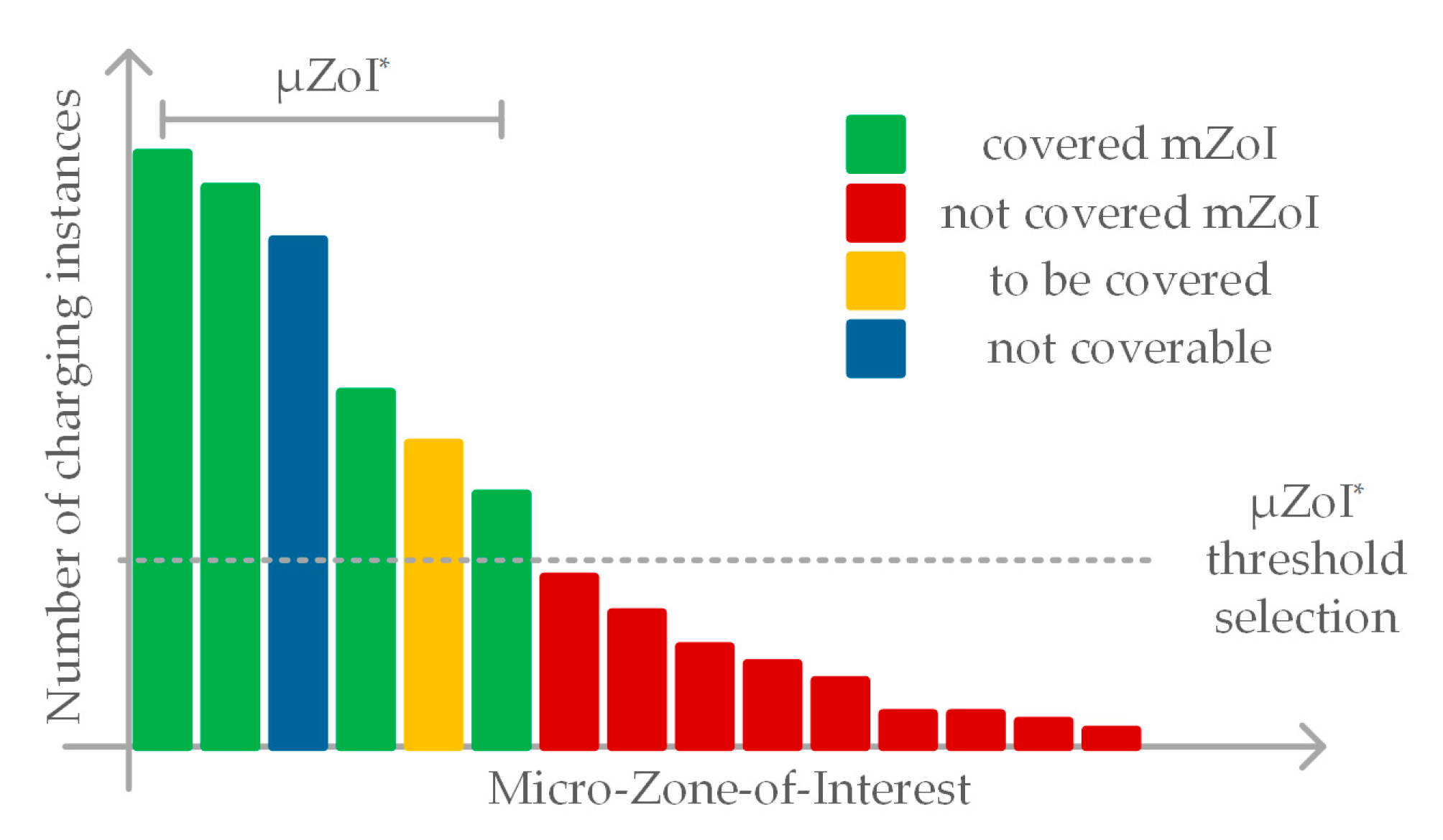
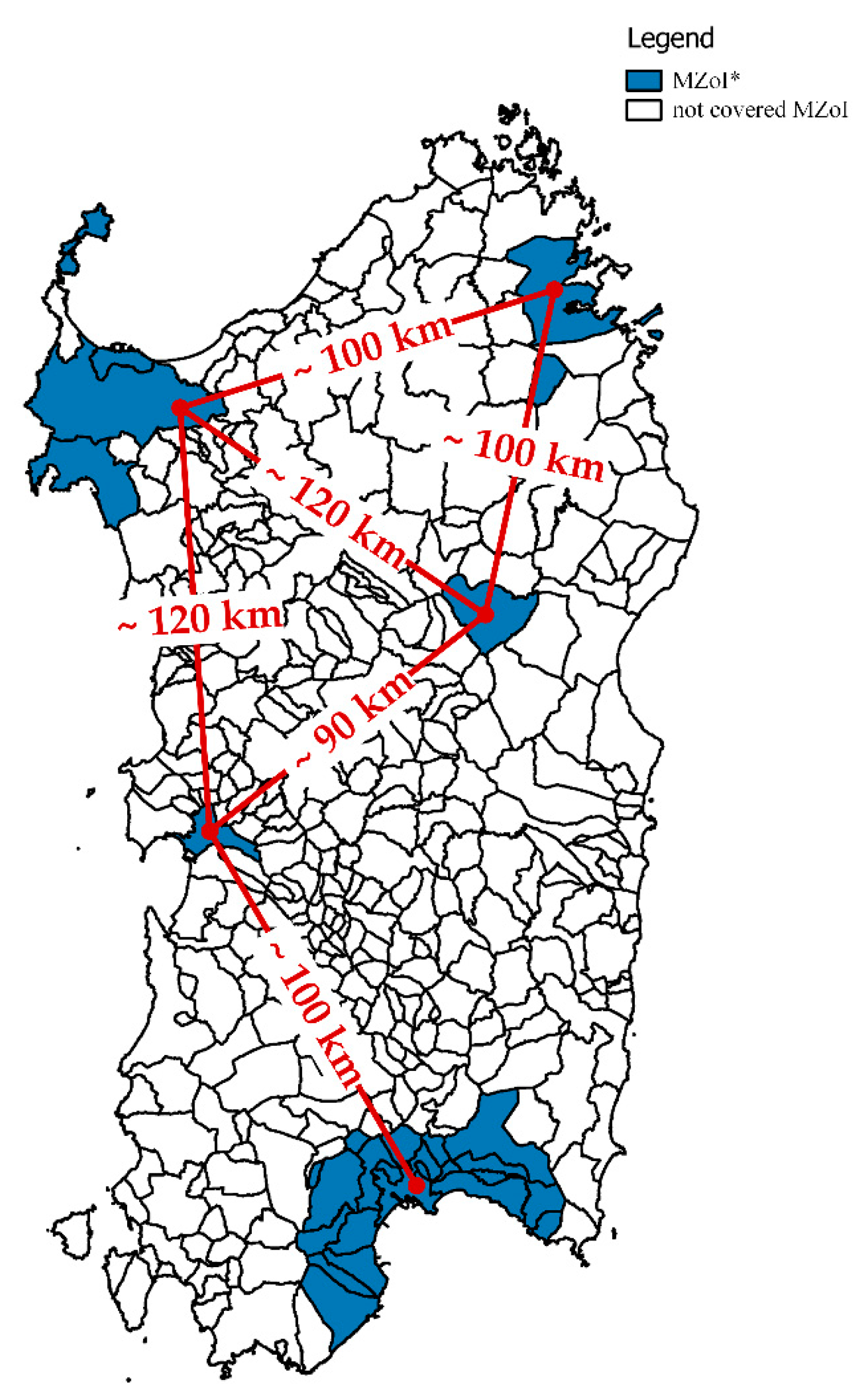
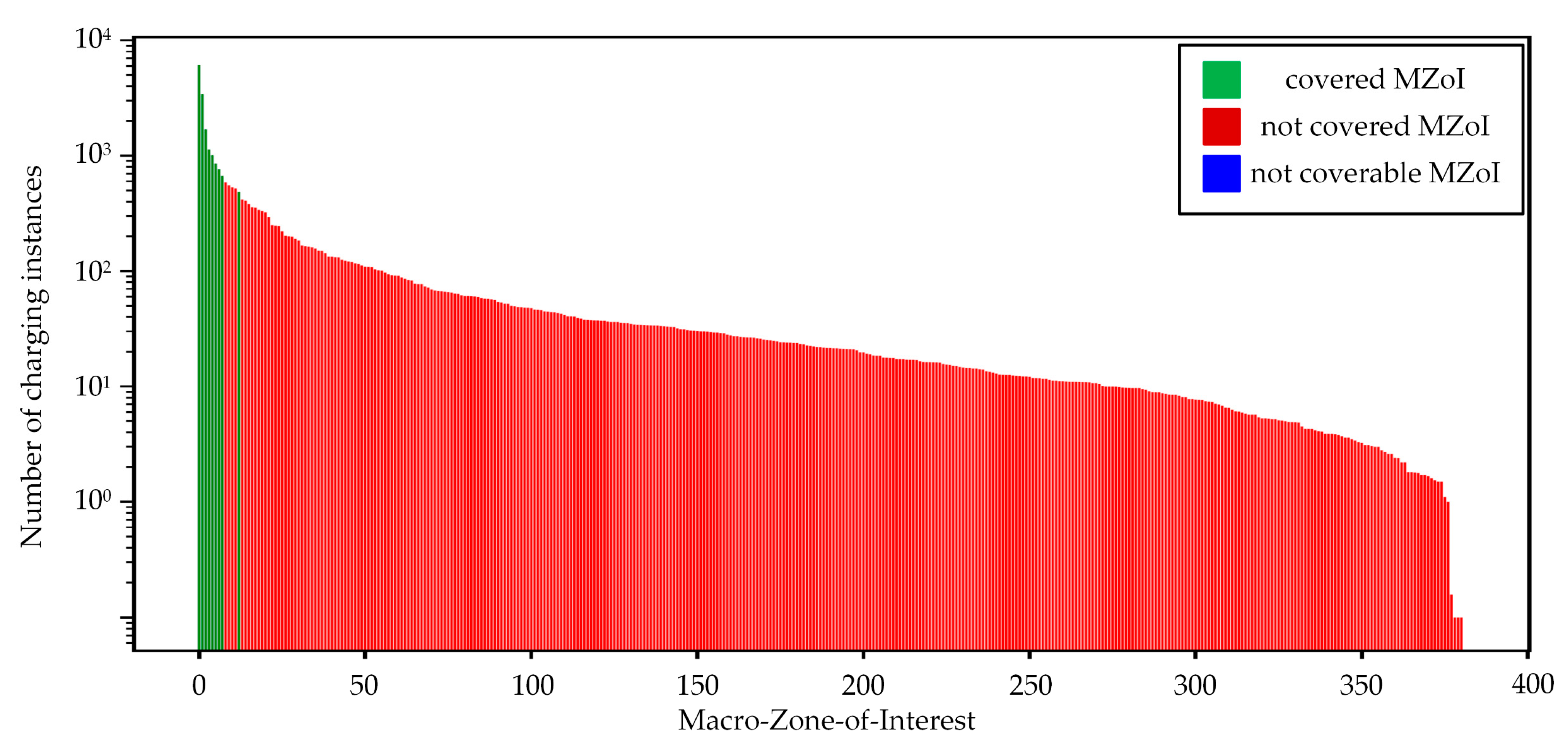
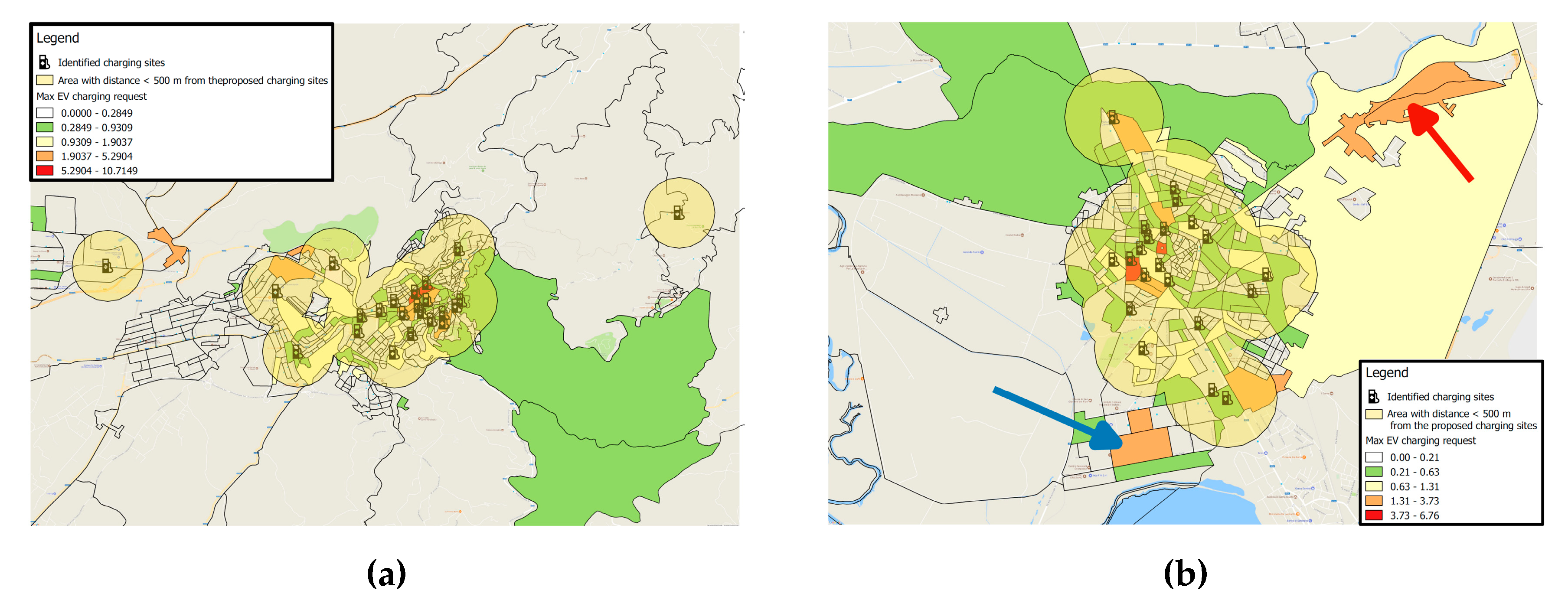
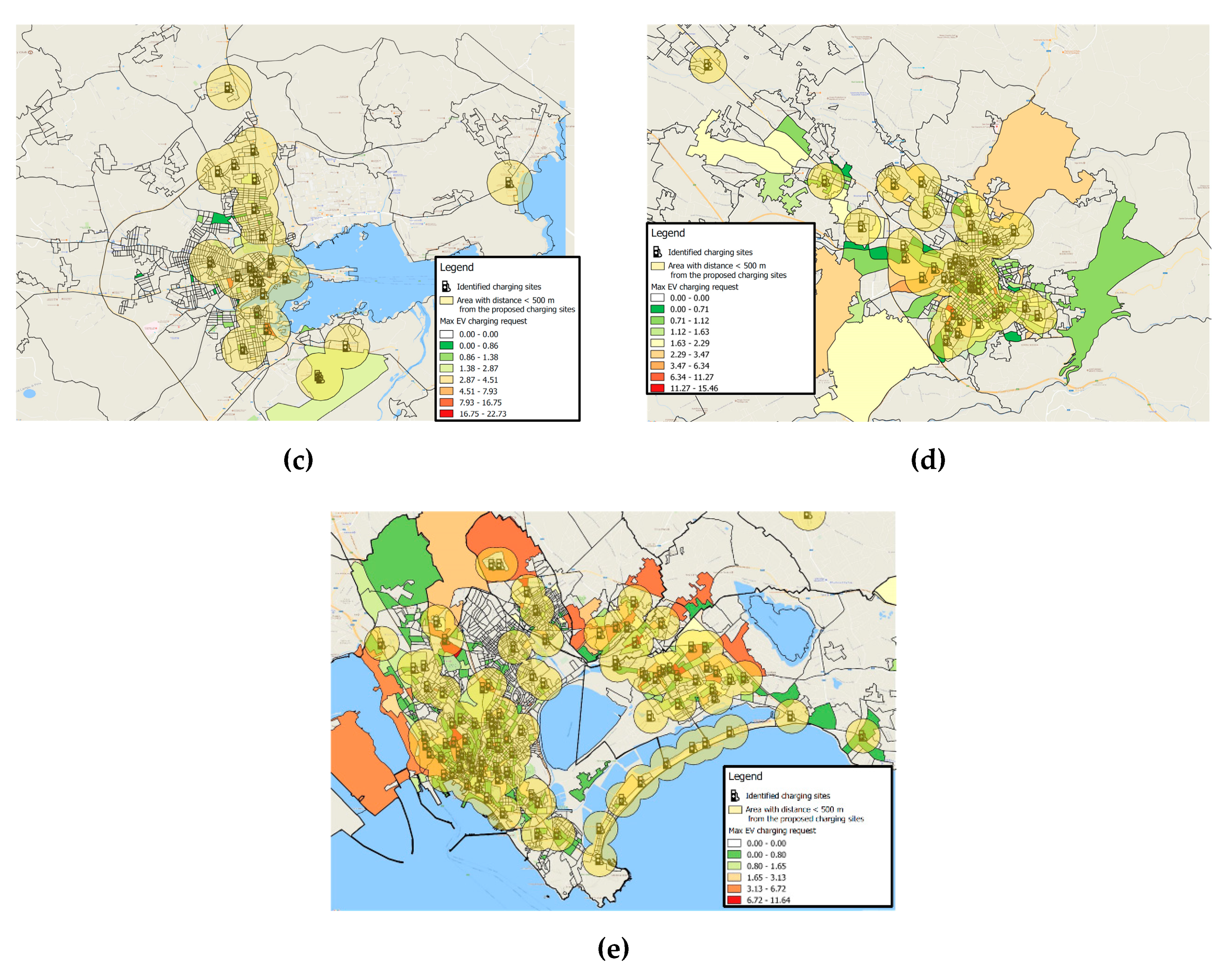
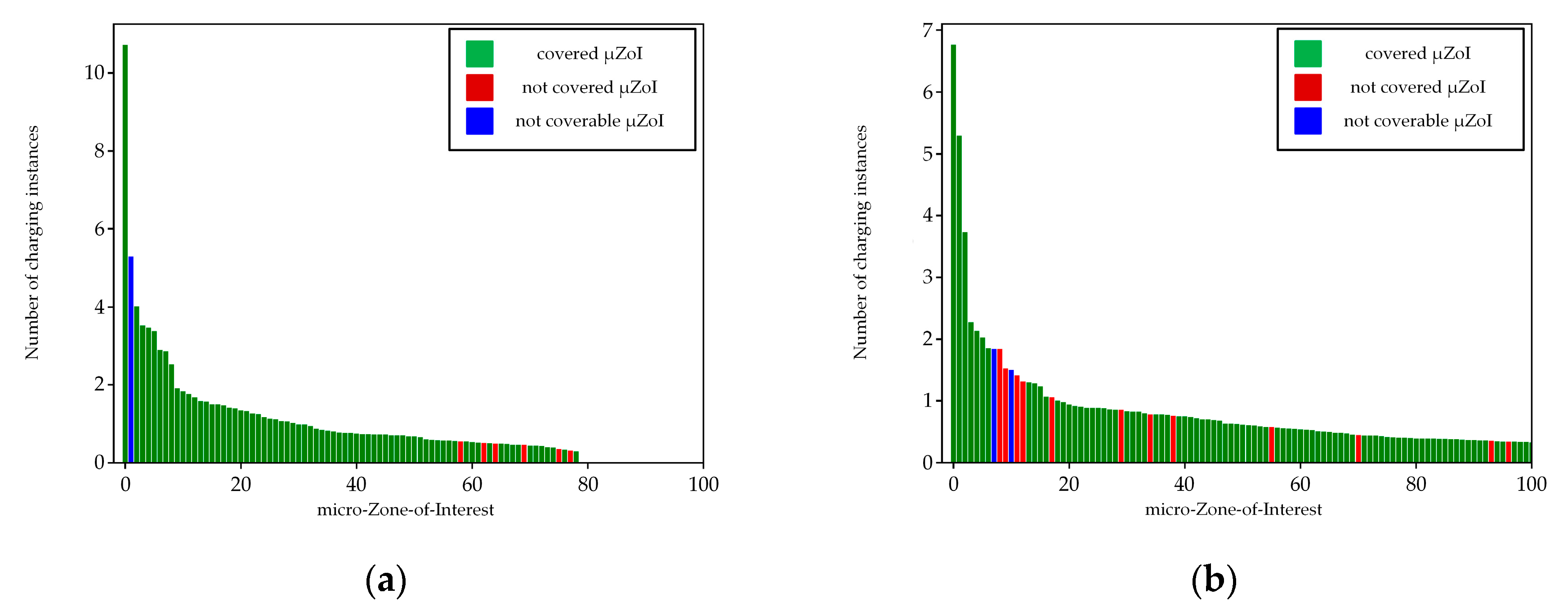
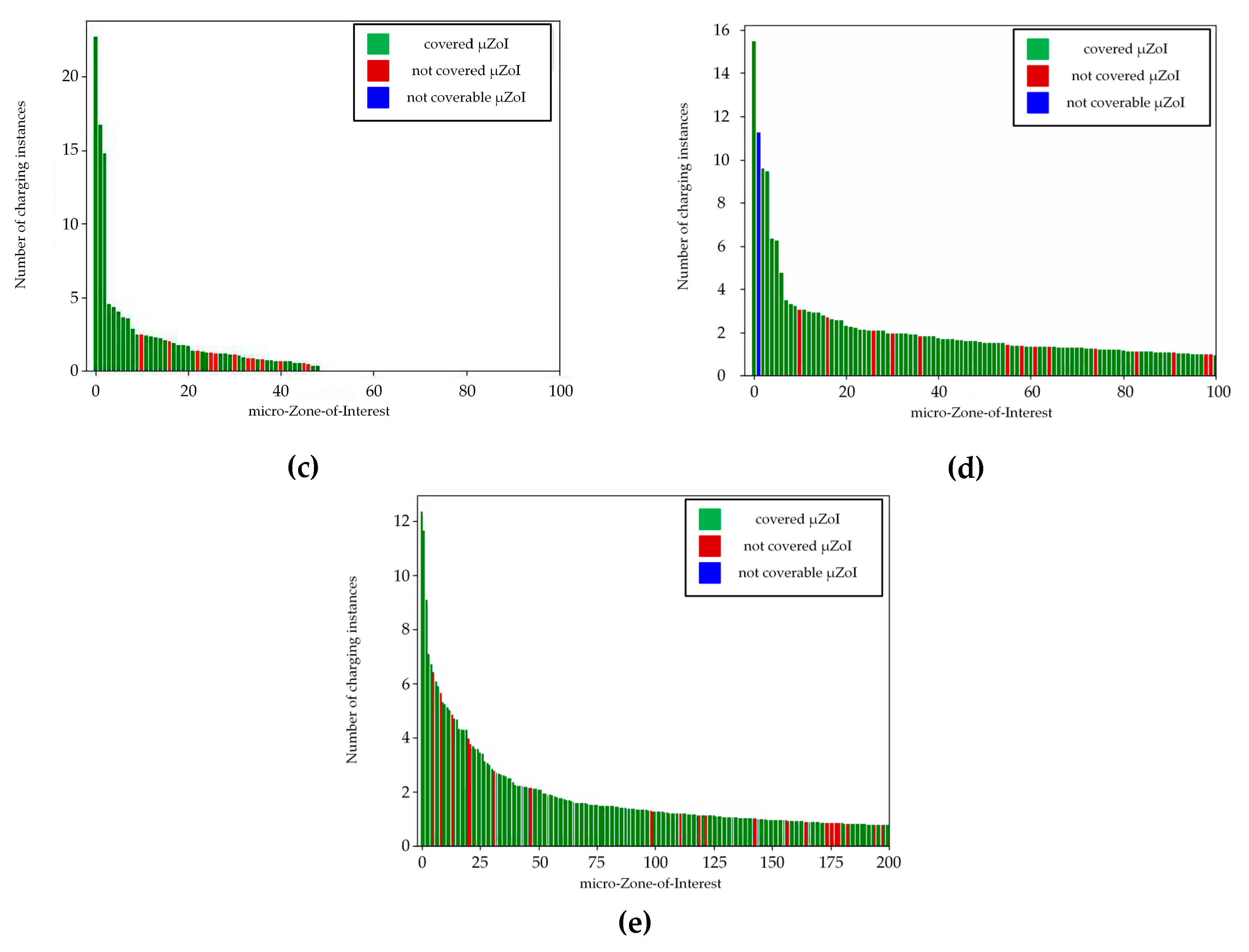
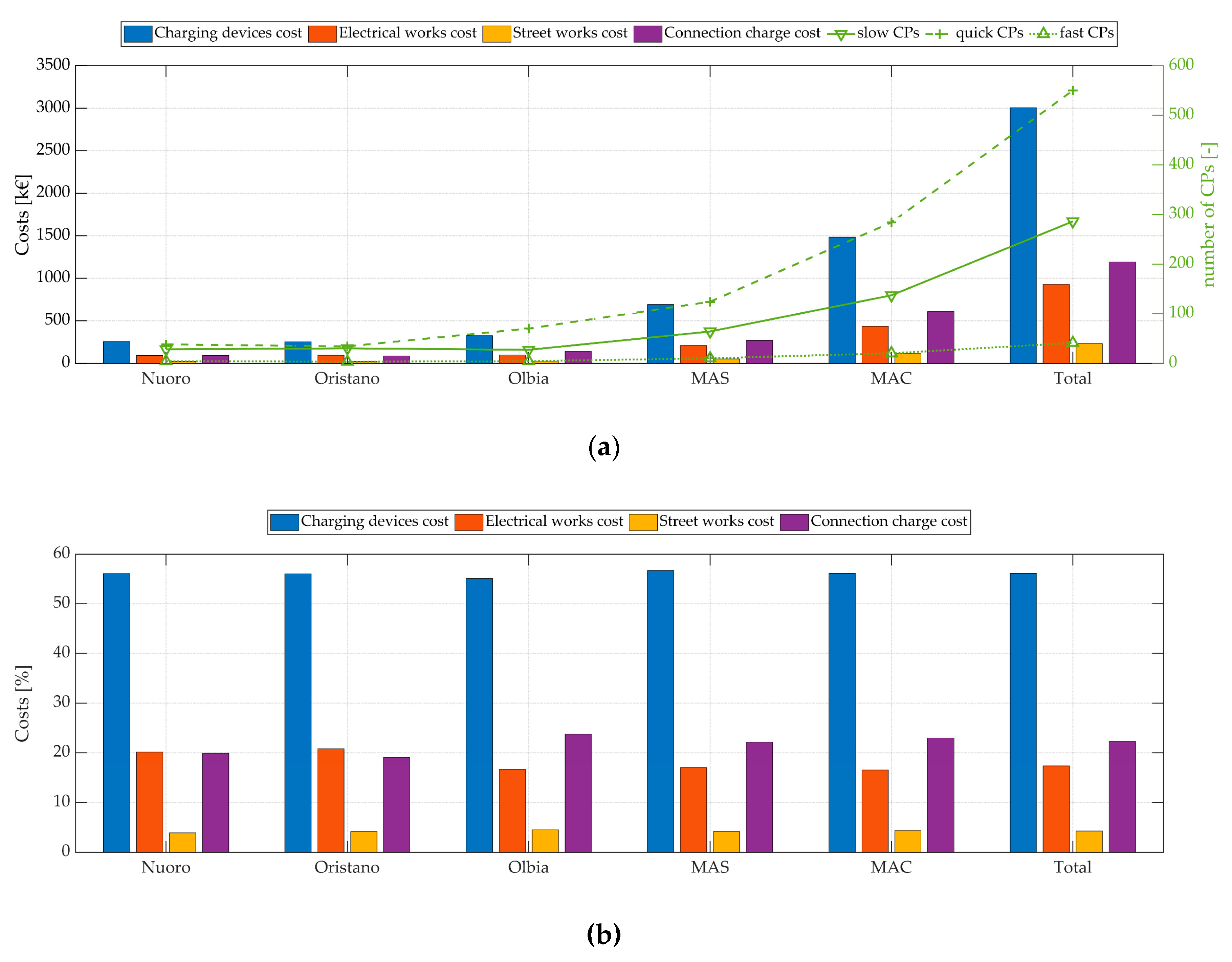
| City | Charging Stations (-) | Fast CPs (-) | Quick CPs (-) | Slow CPs (-) | Installed Power (kW) | ISC [%] |
|---|---|---|---|---|---|---|
| Nuoro | 23 | 4 | 38 | 28 | 1232 | 91.7 |
| Oristano | 23 | 4 | 34 | 30 | 1158 | 85.7 |
| Olbia | 27 | 4 | 70 | 27 | 1929 | 89.4 |
| MAS | 61 | 10 | 124 | 64 | 3676 | 88.3 |
| MAC | 140 | 20 | 284 | 137 | 8262 | 88.6 |
| Total | 274 | 42 | 550 | 286 | 16,316 | - |
| City | Fast CPs (-) | Quick CPs (-) | Slow CPs (-) | Installed Power (kW) |
|---|---|---|---|---|
| Assemini | 0 | 8 | 2 | 190 |
| Cagliari | 4 | 120 | 58 | 3246 |
| Capoterra | 0 | 6 | 3 | 159 |
| Decimomannu | 0 | 6 | 3 | 153 |
| Elmas | 2 | 12 | 5 | 399 |
| Maracalagonis | 0 | 2 | 1 | 51 |
| Monserrato | 0 | 6 | 6 | 174 |
| Pula | 2 | 8 | 3 | 297 |
| Quartu S.E. | 4 | 28 | 15 | 921 |
| Quartucciu | 0 | 4 | 0 | 88 |
| Sarroch | 0 | 20 | 9 | 503 |
| Selargius | 0 | 38 | 18 | 962 |
| Sestu | 1 | 12 | 7 | 413 |
| Settimo S. Pietro | 0 | 2 | 1 | 51 |
| Sinnai | 2 | 4 | 2 | 202 |
| Uta | 4 | 6 | 3 | 353 |
| Villa S. Pietro | 0 | 2 | 1 | 51 |
| Total | 20 | 284 | 137 | 8207 |
| City | Charging Devices k€ (%) | Electrical Works k€ (%) | Street Works k€ (%) | Connection Charge k€ (%) | MZoI Total k€ (%) |
|---|---|---|---|---|---|
| Nuoro | 255.46 | 91.88 | 17.67 | 90.57 | 455.58 |
| (56.07) | (20.17) | (3.88) | (19.88) | (100.00) | |
| Oristano | 251.06 | 93.29 | 18.48 | 85.42 | 448.27 |
| (56.01) | (20.81) | (4.12) | (19.06) | (100.00) | |
| Olbia | 325.16 | 98.20 | 26.72 | 140.14 | 590.23 |
| (55.09) | (16.64) | (4.53) | (23.74) | (100.00) | |
| MAS | 690.10 | 206.67 | 50.35 | 269.30 | 1216.42 |
| (56.73) | (16.99) | (4.14) | (22.14) | (100.00) | |
| MAC | 1481.90 | 436.72 | 115.01 | 607.10 | 2640.73 |
| (56.12) | (16.54) | (4.36) | (22.98) | (100.00) | |
| Total | 3003.68 | 926.76 | 228.24 | 1192.53 | 5351.21 |
| (56.13) | (17.32) | (4.27) | (22.28) | (100.00) |
© 2020 by the authors. Licensee MDPI, Basel, Switzerland. This article is an open access article distributed under the terms and conditions of the Creative Commons Attribution (CC BY) license (http://creativecommons.org/licenses/by/4.0/).
Share and Cite
Porru, M.; Serpi, A.; Mureddu, M.; Damiano, A. A Multistage Design Procedure for Planning and Implementing Public Charging Infrastructures for Electric Vehicles. Sustainability 2020, 12, 2889. https://doi.org/10.3390/su12072889
Porru M, Serpi A, Mureddu M, Damiano A. A Multistage Design Procedure for Planning and Implementing Public Charging Infrastructures for Electric Vehicles. Sustainability. 2020; 12(7):2889. https://doi.org/10.3390/su12072889
Chicago/Turabian StylePorru, Mario, Alessandro Serpi, Mario Mureddu, and Alfonso Damiano. 2020. "A Multistage Design Procedure for Planning and Implementing Public Charging Infrastructures for Electric Vehicles" Sustainability 12, no. 7: 2889. https://doi.org/10.3390/su12072889
APA StylePorru, M., Serpi, A., Mureddu, M., & Damiano, A. (2020). A Multistage Design Procedure for Planning and Implementing Public Charging Infrastructures for Electric Vehicles. Sustainability, 12(7), 2889. https://doi.org/10.3390/su12072889








